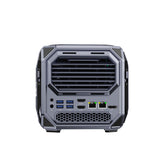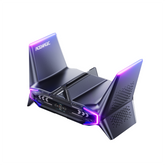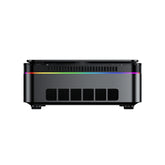How to Transfer Files from PC to PC: Step-by-Step Methods
Transferring files from one PC to another is essentially the process of copying data from a source drive and placing it into a target system. It can involve direct cable connections, wireless transfers, or cloud-based synchronization.
Common situations include:
- Setting up a new computer
- Transferring files from an old computer to a new one
- Backing up important files
- Sharing documents with coworkers
- Migrating to a new operating system
- Freeing up space on your old device

Key Factors to Consider Before Transferring
Before starting the transfer, several elements should be reviewed to avoid issues like data loss or corrupted files.
Checklist:
- File Size: Larger files naturally take longer to move. A 100 GB transfer over Wi-Fi could drag on for hours, but with a USB 3.2 drive offering 5–10 Gbps speeds, you’ll get it done much faster.
- Connection Speed: Evaluate whether your local network or hardware supports high-speed transfer.
- Storage Space: Confirm the destination PC has enough disk capacity to receive the files.
- File Format Compatibility: Check if both systems can read file types such as .docx, .mp4, or .zip.
- Security Level: Sensitive or confidential data may need encryption or password-protected archives.
- Operating System Version: File sharing between different OS versions (e.g., Windows 10 and Windows 11) may require updated sharing settings.
Understanding these basics helps identify the best file transfer method for your setup and ensures a smooth, secure process.
Method 1: Transfer Files Using an External Storage Device
Transferring files with an external storage device is one of the most direct and reliable methods. It works offline and requires no network configuration, which makes it ideal for users moving data between two Windows PCs or from an old computer to a new one.

Step-by-Step Instructions
The process involves only a few simple actions. Use a USB flash drive or an external hard drive that has enough capacity for your data.
Steps:
- Connect the device to the source PC using a USB port.
- Open File Explorer and locate the files or folders you want to move.
- Copy the selected files (Ctrl + C).
- Open the external drive from “This PC” and paste the files (Ctrl + V).
- Safely eject the device once the transfer is complete.
- Plug the drive into the target PC and copy the files to the desired location.
This method is also practical when transferring files between systems that are not on the same network or when security policies restrict online transfers.
Pros and Cons of Using External Drives
External storage devices are efficient for physical data transfers, but they come with their own strengths and limitations.
| Aspect | Advantages | Limitations |
|---|---|---|
| Speed | USB 3.2 and SSD-based drives can reach up to 10 Gbps. | Slower on older USB 2.0 ports (max 480 Mbps). |
| Security | No internet connection reduces exposure to online risks. | Lost drives can lead to data leaks if not encrypted. |
| Ease of Use | Plug-and-play compatibility on most systems. | Manual copying is required for large folder structures. |
| Cost | Affordable and reusable for backups. | May need larger drives for very big data transfers. |
| Offline Use | Works without Wi-Fi or LAN setup. | Physical transfer takes time over long distances. |
External storage remains one of the most dependable file transfer methods for both personal and professional use. For users who value data control and offline capability, this option provides a secure and simple way to transfer files from PC to PC without relying on the internet.
Method 2: Transfer Files via Local Network or Wi-Fi
Transferring files between two PCs on the same network is efficient for users who prefer wireless or cable-free sharing. It eliminates the need for physical drives and allows direct file exchange through a home or office Wi-Fi connection.

How to Set Up File Sharing in Windows
Windows includes a built-in feature for local file sharing. It allows two or more computers connected to the same network to exchange data quickly.
Steps:
- Connect both computers to the same Wi-Fi or LAN network.
- Open File Explorer and right-click the folder you want to share.
- Select Properties → Sharing → Advanced Sharing.
- Enable Share this folder and choose user permissions (Read/Write).
- On the second PC, open Network in File Explorer to view the shared folder.
- Copy and paste files to or from the shared directory.
This process enables both systems to send and receive data over the local network without extra software.
Using Nearby Sharing (Windows 10/11)
For Windows 10 and 11 users, Nearby Sharing provides a faster alternative to traditional network folders. It uses Bluetooth and Wi-Fi Direct to transfer files between compatible PCs within range.
To activate Nearby Sharing:
- Go to Settings → System → Nearby sharing.
- Choose Everyone nearby to make the PC discoverable.
- Open File Explorer, right-click a file, and select Share.
- Choose the target device from the list of nearby computers.
- Accept the transfer request on the receiving PC.
This feature works best for medium-sized files such as documents, images, and presentations. Large video files may take longer depending on Wi-Fi speed.
Pros and Limitations
| Aspect | Advantages | Limitations |
|---|---|---|
| Speed | Fast for small to medium files over Wi-Fi 6 or wired LAN. | Performance depends on network strength. |
| Convenience | No cables or external drives needed. | Both PCs must be online and nearby. |
| Setup | Built-in in Windows, no third-party tools required. | Configuration errors can block sharing. |
| Security | Local transfers stay within the same network. | Public networks can expose data if sharing isn’t restricted. |
| Scalability | Suitable for home or small office use. | Not ideal for transferring terabytes of data. |
Wi-Fi or LAN sharing is practical for users who regularly exchange files between home or office PCs. It’s a balanced method between convenience and performance, especially when both computers use Windows 10 or 11.
Method 3: Transfer Files Using Cloud Storage
Cloud storage is one of the most flexible file transfer methods because it works across different devices and operating systems. It allows users to upload files to a secure online server and download them from another computer using the same account. This approach is especially useful for remote workers or anyone needing to transfer files from PC to PC without direct access to both devices.

Upload and Download Process Explained
The process is straightforward and suitable for both personal and business use.
Steps:
- Choose a cloud service such as Google Drive, OneDrive, or Dropbox.
- Sign in with your account and open the web or desktop app.
- Upload files or folders from your source computer.
- On the second PC, sign in to the same account.
- Download or sync the uploaded files to the local drive.
Cloud storage is particularly effective for smaller batches of files or when transferring data between distant locations. For large datasets, syncing may take longer depending on upload speed and storage plan.
Best Cloud Services for File Transfer
| Service | Free Storage | Upload Speed | Best Use Case |
|---|---|---|---|
| Google Drive | 15 GB | Medium | Everyday file sharing and document access |
| OneDrive | 5 GB | Fast (integrated in Windows) | Seamless sync between Windows PCs |
| Dropbox | 2 GB | High | Team collaboration and link sharing |
| Mega | 20 GB | Medium | Encrypted file transfers |
| iCloud Drive | 5 GB | Medium | Cross-device sharing for Apple users |
These services integrate easily with Windows or browser-based environments, offering features like automatic synchronization, version history, and sharing permissions.
Security and Privacy Tips
When using cloud storage, protecting your data should remain a top priority. Consider these practices:
- Activate two-factor authentication to secure account access.
- Encrypt sensitive files before uploading using tools such as 7-Zip or VeraCrypt.
- Regularly check sharing permissions to avoid unauthorized access.
- Use private networks when uploading or downloading large volumes of data.
Cloud storage combines accessibility and reliability, making it one of the best ways to transfer files between computers when speed and remote availability are important.
Method 4: Using File Transfer Software or Migration Tools
Use third-party migration tools to move files, applications, and account settings between two PCs. These tools reduce manual steps and help when moving a full user profile or many installed programs.

Recommended Tools and Use Cases
- Laplink PCmover — Moves files, applications, and settings; suitable for full PC migration when moving to a new machine.
- EaseUS Todo PCTrans — Offers PC-to-PC transfer and image-based transfer; useful for selective file and app moves.
- Acronis True Image / Macrium Reflect — Create disk images and restore them to a new drive; suitable for full-disk cloning.
- Clonezilla — Open-source disk cloning for technicians and advanced users.
Use cases:
- Move a full user profile to a new PC.
- Transfer installed programs and their settings.
- Clone a system drive to a larger SSD.
Step-by-Step Example: EaseUS Todo PCTrans (PC-to-PC mode)
This example shows typical steps for a network-based migration. Exact labels may differ by version.
- Install the software on both source and target PCs.
- Open the app on both machines. Select the PC-to-PC transfer mode on each side.
- Establish a connection. Let the apps discover each other on the same network, or enter the IP/connection code if prompted.
- Scan available items on the source PC. The software lists user accounts, files, and compatible applications.
- Select items to transfer. Check folders, files, or applications you need. Confirm available disk space on the target PC.
- Start the transfer. Monitor progress on both PCs. Wait for completion and follow any prompts to restart.
- Verify results. Open moved files and run transferred applications. Reactivate any software that requires a license key.
Tips for the example above: use a wired Ethernet connection for faster transfer and disable sleep mode on both PCs during the move.
Pros and Cons of Migration Tools
| Aspect | Pros | Cons |
|---|---|---|
| Scope | Transfer files, apps, and settings in one flow | Some system files and drivers may not transfer |
| Speed | Faster than manual copy for many small files | Speed depends on the network and the hardware |
| User effort | Fewer manual steps | Paid licenses are required for full features |
| Reliability | Preserves folder structure and some app settings | Some apps require reinstallation or reactivation |
| Use case | Best for full PC setup or large migrations | Not ideal for single large file moves (use LAN/USB instead) |
Licensing, Cost, and Limitations
- Free editions often restrict the number of transferable applications or total data size.
- Professional editions add app transfer, priority support, and unlimited data moves.
- License activation rules may require deactivating software on the old PC before use on the new one.
- Migration tools rarely move system drivers or OS-level components; a clean OS reinstall is safer for system stability in some cases.
When to Choose Migration Tools
Choose migration software when the goal is a near-complete workspace transfer: many installed applications, user profiles, and personalized settings. Choose cloning tools when the objective is an exact disk copy (system image). For single folders or occasional files, use USB, LAN, or cloud methods instead.
Method 5: Transfer via LAN Cable or Direct Connection
Connect two PCs directly with an Ethernet or transfer cable for high-speed file exchange without relying on Wi-Fi or external storage. This method provides faster, stable throughput, ideal for large data volumes.

When to Use a LAN Cable Transfer
Use a LAN cable transfer if:
- Both PCs are close enough for a cable connection.
- You need to move hundreds of gigabytes quickly.
- Your Wi-Fi is unstable or slow.
- You prefer offline transfer without the cloud.
Types of cables supported:
- Ethernet (Cat5e or Cat6) — For PCs with network ports.
- USB Transfer Cable — Has built-in bridge chips for easy setup via software.
💡Tip: Ethernet provides the highest speed and widest compatibility, while USB transfer cables are convenient for laptops without Ethernet ports.
Method A: File Sharing over Ethernet (Windows Network Setup)
Use this method when both PCs are on Windows 10 or 11 and share the same local network.
Steps:
- Connect the PCs using a LAN cable.
- Enable network discovery and file sharing:
- Go to Control Panel → Network and Sharing Center → Advanced sharing settings.
- Turn on “Network discovery” and “File and printer sharing.”
- Assign the same workgroup:
- Right-click This PC → Properties → Advanced system settings → Computer Name → Change.
- Set both PCs to the same “Workgroup” name.
- Share a folder:
- Right-click the target folder → Properties → Sharing → Advanced Sharing → Share this folder.
- Access from the second PC:
- Open File Explorer and type \\PCName or \\IPaddress in the address bar.
- Enter the credentials if prompted and copy files.
Advantages: No external drive needed, high transfer speed (up to 1 Gbps or more).
Caution: Configure file permissions properly to avoid unwanted access.
Method B: Using a USB-to-USB Data Transfer Cable
Some USB cables (like Plugable or J5create models) include built-in chips and companion software for guided transfers.
Steps:
- Plug in the USB cable to both PCs.
- Wait for the bundled software to launch automatically (e.g., Easy Computer Sync).
- Select “Transfer files” and choose source → destination.
- Drag and drop files in the software interface.
✅Advantages: No network setup needed.
Disadvantages: Usually slower than Ethernet; cable cost slightly higher.
Ethernet vs. USB Transfer: Comparison Table
| Aspect | Ethernet Cable | USB Transfer Cable |
|---|---|---|
| Speed | Up to 1 Gbps (wired LAN) | 20–480 Mbps depending on USB type |
| Ease of setup | Requires manual sharing setup | Plug and play with software |
| Compatibility | Works on all OS with Ethernet | Needs specific drivers/software |
| Cost | Very low | Slightly higher |
| Best for | Large file volumes, backups | Quick one-off transfers |
Common Problems and Fixes
| Issue | Likely Cause | Quick Fix |
|---|---|---|
| PCs can’t see each other | Network discovery off | Enable in “Advanced Sharing Settings” |
| Transfer very slow | Cable or port limited | Use Cat6 cable and Gigabit ports |
| Permission denied | Folder not shared properly | Set “Everyone” to Read/Write |
| IP conflict | Both PCs are using DHCP | Set one to a static IP |
Best Practices
- Keep both PCs plugged into power during long transfers.
- Disable sleep mode on both systems.
- Use Gigabit Ethernet or higher for faster throughput.
- After the transfer, turn off sharing to protect sensitive folders.
Troubleshooting Common Transfer Issues
Even with the right tools, file transfers between PCs can sometimes fail due to permissions, connection issues, or incompatible formats. This section covers the most frequent causes and step-by-step fixes to ensure your transfer completes successfully.
1. Files Not Transferring or Process Stops Midway
If a transfer freezes or cancels before completion, it usually indicates a connectivity or permission problem.
Possible Causes and Fixes:
Unstable connection:
- If using Wi-Fi, switch to a wired Ethernet connection for stability.
- Reconnect or restart both PCs before resuming the transfer.
Insufficient disk space:
- Check free storage on the destination drive; leave at least 10–15% space for temporary data.
Large file size limits:
- FAT32 drives can’t store files larger than 4 GB — reformat to exFAT or NTFS.
File path too long:
- Shorten file or folder names; Windows limits total path length to 260 characters.
Tip: Use file compression (ZIP or 7z) to bundle many small files into a single transfer-friendly package.
2. PCs Can’t Detect Each Other Over the Network
Network sharing can fail due to disabled services, firewall rules, or incorrect network profiles.
Fix Steps:
- Ensure both PCs are on the same network and have unique names.
- Open Settings → Network & Internet → Status → Network and Sharing Center.
- Turn on:
- Network discovery
- File and printer sharing
- Disable “password-protected sharing” temporarily (test only).
- If still failing, open Windows Defender Firewall → Allow an app through firewall and ensure File and Printer Sharing is checked for both Private and Public networks.
- Reboot both devices and try accessing via: \\PC-Name or \\192.168.x.x
Tip: If one PC uses Wi-Fi and the other uses Ethernet, confirm they’re under the same subnet (e.g., 192.168.1.x).
3. Slow Transfer Speeds
Even with the correct setup, you might experience very slow transfer rates.
Common Causes and Solutions:
Using outdated cables or ports:
- Ensure USB 3.0 (blue port) or Gigabit Ethernet is used instead of older standards.
Background processes:
- Pause antivirus scans or heavy downloads temporarily.
File fragmentation or large numbers of small files:
- Compress files into a single archive before moving.
Hard drive bottlenecks:
- Transfer between SSDs when possible; HDDs read/write much slower.
Benchmark reference:
| Transfer Type | Expected Speed |
|---|---|
| USB 2.0 | 20–30 MB/s |
| USB 3.0 | 80–150 MB/s |
| Gigabit Ethernet | 100–120 MB/s |
| Wi-Fi (5 GHz) | 30–80 MB/s |
4. Permission or Access Denied Errors
Windows file protection and NTFS permissions often block shared file access.
Fix Steps:
- Right-click the folder → Properties → Sharing → Advanced Sharing.
- Enable “Share this folder” and click “Permissions.”
- Add Everyone → Allow: Read/Write.
- Under the Security tab, ensure the user or group has “Modify” rights.
- Apply changes and recheck the transfer.
Alternative fix: Copy files into a public folder (C:\Users\Public) and transfer from there.
5. Transferred Files Are Missing or Corrupted
If transferred files won’t open or are incomplete:
- Incomplete transfer: Try smaller batches instead of large bulk moves.
- Antivirus interference: Temporarily disable real-time scanning.
- Damaged storage media: Test the drive using chkdsk /f or a disk health utility.
- File name encoding issues (from older PCs): Rename with standard English characters before transfer.
Verification tip: Use checksum tools (like MD5 or SHA256) to verify integrity for critical files.
6. USB or External Drive Not Recognized
When using external storage, detection failures are common.
Fix Steps:
- Try a different USB port (preferably rear I/O on desktops).
- Open Disk Management → Check if the drive appears as unallocated.
- Assign a drive letter: Right-click → Change Drive Letter and Paths → Add.
- Update USB or chipset drivers if the device still doesn’t show.
- Test the drive on another PC to rule out hardware failure.
Error Messages During Transfer
Common Windows errors and what they mean:
| Error Message | Meaning | Solution |
|---|---|---|
| “The destination file could not be created” | File in use | Close all open files/programs |
| “Cannot copy file: Access is denied” | Permission issue | Change folder permissions |
| “Not enough quota” | Storage full | Free disk space |
| “Network path not found” | Connection lost | Reconnect or restart both PCs |
Preventing Future Transfer Problems
- Regularly update your network drivers and Windows version.
- Label shared folders clearly and use consistent permissions.
- Avoid moving system files or program folders manually; use migration tools for them.
- Keep at least 10% free space on both source and target drives for smooth operation.
- Always verify file count and size after transfer to confirm completeness.
Conclusion
Whether you use cloud storage, external drives, LAN cables, or dedicated transfer tools, moving files from one PC to another is no longer a difficult task. By choosing the right method for your setup and taking basic precautions, you can migrate all your data smoothly and securely.
Always double-check that all files are transferred successfully, keep a backup on a separate device or in the cloud, and protect both systems with updated security settings. These simple steps prevent data loss and help your new PC run as intended from day one.
If you are upgrading your computer setup, consider a reliable and compact solution. ACEMAGIC Mini PCs offer powerful performance, high-speed connectivity, and flexible storage options—ideal for users who frequently handle large file transfers or manage multiple devices.
For more guides on optimizing your PC experience and maintaining peak performance, visit the ACEMAGIC blog to explore practical tips, comparisons, and setup tutorials designed for modern users.
Recommended articles
- How to Connect Phone to Computer?
- How to Fix USB Device Not Recognized: Step-by-Step Troubleshooting Guide
- Why Is Your Internet So Slow? 10 Common Causes and Fixes
-
What does Defragmentation do and Why It Matters
FAQ
What’s the fastest way to transfer files between two PCs?
Using a LAN cable or dedicated transfer software is typically the fastest. A Gigabit Ethernet connection can reach speeds over 100 MB/s, far faster than Wi-Fi or USB 2.0.
Can I transfer files from PC to PC without the Internet?
Yes. You can connect the two computers directly using a LAN cable or use a USB flash drive or an external hard drive for offline transfers.
How do I transfer files from an old PC to a new one?
For full migration, including settings, use PCmover, EaseUS Todo PCTrans, or Windows Migration Assistant. For documents and photos only, USB drives or cloud storage are simpler choices.
Are there file size limits when using cloud storage?
Yes. Services like Google Drive and OneDrive limit individual file uploads to around 5–15 GB per file. For larger files, compress them or use transfer tools such as WeTransfer or pCloud Transfer.
Can I transfer installed programs or applications?
Standard file transfers move only files and folders. To move programs, use migration software designed for application-level transfers—manual copying will not work for most installed apps.
Is it safe to use USB drives for large data transfers?
Yes, but scan them for malware first and use drives formatted as NTFS or exFAT to avoid size limitations. Avoid unplugging the device during transfer to prevent corruption.
How can I transfer files between Windows and Mac computers?
You can use cloud storage, external drives formatted as exFAT, or FTP servers. These methods are cross-compatible and avoid common format issues like NTFS write restrictions on macOS.
What should I do if the file transfer stops midway?
Restart both PCs, check for available storage, and try moving smaller batches of files. If using Wi-Fi, switch to a wired connection for a more stable transfer.






